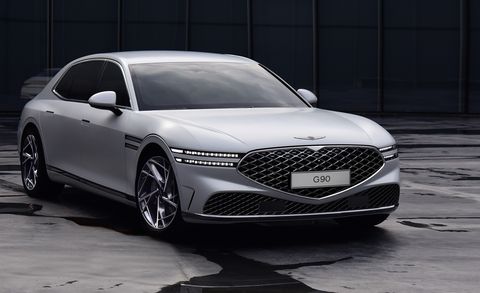Hyundai Promises 50 Percent More EV Range, OTA Updates in the Coming 'Software Age'

Software-defined vehicles (SDVs) are cars that change important aspects of their performance based on new lines of code. With over-the-air updates, SDVs can adjust everything from infotainment to safety features to self-driving capabilities.Hyundai will spend $12.6 billion by 2030 on what it is calling the upcoming Software Age for vehicles.While some of today’s Hyundai Group vehicles can already be updated over cellular networks, the first vehicles that are part of this new Software Age will arrive in 2023.
Hyundai Motor Group will invest $12.6 billion by 2030 to make lines of code the most critical part of future Hyundai, Kia, and Genesis vehicles. The automaker announced its roadmap for software-defined vehicles today and said it expects to have 20 million vehicles around the world be part of the Group’s Connected Car Services (CCS) by 2025. That’s also the year that all Hyundai Group models will be considered software-defined vehicles (SDVs).
Hyundai
Hyundai is calling its shift to get more SDVs on the road the “Software Age.” The technology—in which updatable code controls and changes a vehicle’s components, parameters, and features—will be used in electric and traditional gas-powered cars. Many Hyundai Group vehicles are already defined in some way by software that can be updated over the air. Current OTA services revolve around infotainment, connectivity and ADAS features, but Hyundai is promising more of everything when it comes to future SDVs. The first vehicles that reflect the brand’s wholesale commitment to the SDV era will arrive in 2023, according to Hyundai electronics development group vice president Hyung Ki Ahn. These SDVs will offer better environmental recognition and improved autonomous driving and parking features.
50 Percent More Range
Hyundai will introduce two new electric vehicle platforms as part of its embrace of SDVs. Compared to Hyundai’s current E-GMP platform, used in the Hyundai Ioniq 5, Kia EV6, and Genesis GV70, the new platforms will offer more range and better use of OTA updates for improvements. The first platform, called eM, will be used for passenger vehicles in all segments and promises to offer a 50 percent range improvement compared to current EVs. Hyundai is building the eM platform with Level 3 and higher autonomous driving technology in mind. The eS “skateboard” platform will be used for purpose-built vehicles, especially for companies that use vehicles for deliveries or ride-hailing. The first Hyundai Group vehicles that use these new electric platforms will arrive in 2025.
While some OTA features can be found on vehicles that customers already own, the core of Hyundai’s new SDV future is its internally developed Connected Car Operating System (ccOS). The ccOS platform uses an integrated controller to make software updates more efficient. Hyundai is also working with NVIDIA to load an optimized ccOS onto the NVIDIA DRIVE high-performance semiconductor. Faster, better semiconductors are required because of the massive data collection and processing requirements of new vehicle functions, including information from the car’s camera, radar, and lidar sensors. Before the end of the year, Hyundai will add an advanced Highway Driving Pilot (HDP) to the Genesis G90 (pictured below) that will offer Level 3 semi-autonomous driving features. Hyundai is also moving its Remote Parking Pilot (RPP) to Level 3 standards. For Level 4 functionality, Hyundai is looking at chip options from multiple suppliers.

More Subscriptions?
Hyundai’s customers will, of course, have to pay for these updatable features in some fashion, and the automaker touts SDVs and Feature on Demand (FoD) services as a way to provide “diverse, stable revenue streams.” That, of course, brings us into the tricky world of ongoing subscriptions for vehicle features. BMW caused a ruckus earlier this year when it announced heated seat subscriptions for its vehicles in the UK. BMW claimed that a feature like this can be purchased for one up-front cost or paid for over time and that different payment options help consumers. Hyundai didn’t address the BMW situation but claimed that SDVs put customers in charge and said constant updates would help with a car’s residual value.
“Our theory is that customers can use what they want,” Ahn said on a conference call announcing the news. “At the same time, customers who do not want the feature can stop using the feature without incurring any further cost. Being able to use the features you want when you want them and pay for what you use is a service that is made possible by SDV technology.”
Ahn said Hyundai is researching how customers may respond to different updatable functions and prices.
This content is imported from OpenWeb. You may be able to find the same content in another format, or you may be able to find more information, at their web site.



